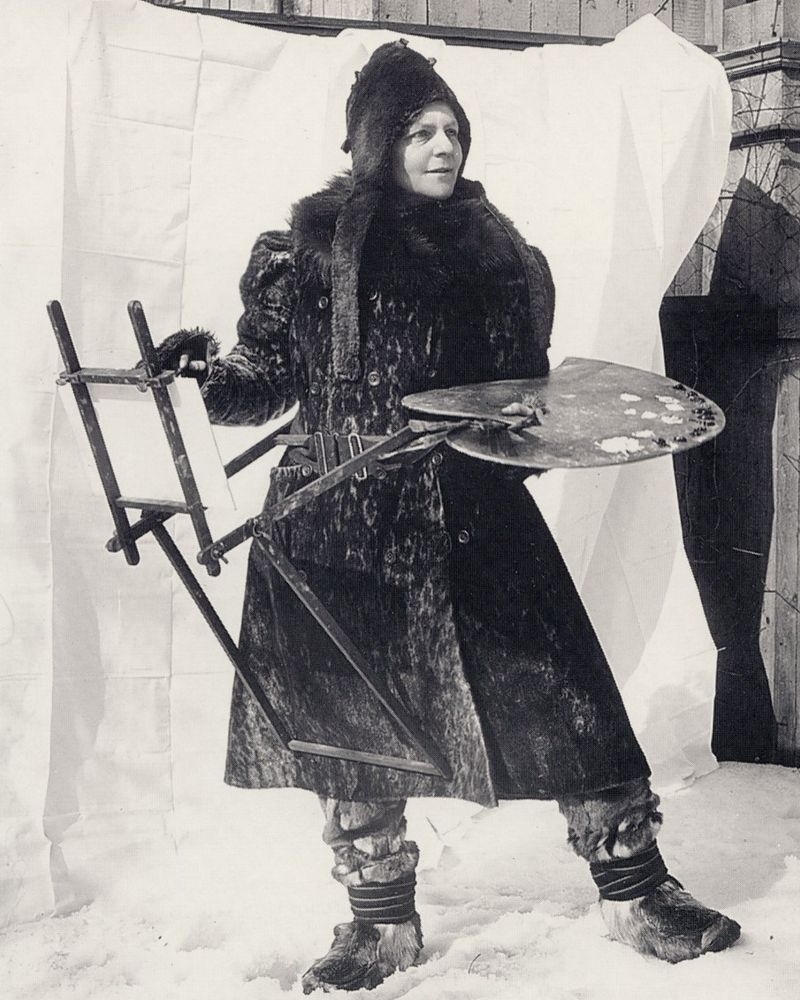Anna Boberg
Anna Boberg (née Scholander) was born into a culturally prominent family in Stockholm. Her father, Fredrik Wilhelm Scholander (1816 - 1881), was a renowned architect and professor at the Royal Swedish Academy of Arts (counting among his many important buildings: the Stockholm Synagogue, the Bernadotte Royal burial chapel at Riddarholmen Church and several interiors at Drottningholm Royal Palace as well as the Royal Palace in Stockholm). Boberg’s close ties to Swedish architecture were strengthened after her marriage to Ferdinand Boberg (1860 - 1946), one of Sweden’s most celebrated architects in the early 20th century who drew up the plans for some of Stockholm’s landmark structures back then, like: Rosenbad (which today houses the Swedish Prime Minister’s Office and the Government Chancellery), 1903-04; Villa Eolskulle (currently a much loved art museum under the name Thiel Gallery but originally built as a private residence and art gallery for banker and collector Ernest Thiel [1859 - 1947]), 1904-07; Prince Eugene’s Waldemarsudde (also currently a much loved art museum but formerly the home of Prince Eugene [1865 - 1947], Swedish prince, painter and art collector), 1905/1913 and Nordiska Kompaniet (Stockholm’s most exclusive department store), 1915.
Anna Boberg was herself a multitalented artist and designer; initially working with ceramics and textiles. One early example of Boberg’s talent as a designer is found in the famous ‘Peacock vase’ that she created for famous Swedish porcelain manufacturer Rörstrand in 1897 (a version, from c. 1900, of which was sold at Christie’s in London, 2014 for 68,500 GBP). The Jugend-style also characterised Boberg’s commissions as a designer for Handarbetets Vänner (Friends of Handicrafts) and Nordiska Kompaniet’s textile section. As pointed out by Anna Lena Lindberg (in Anna Katarina Boberg, www.skbl.se/sv/artikel/Anna Boberg, Svenskt kvinnobiografiskt lexikon, article by Anna Lindberg, retrieved 2025-03-10) Boberg’s “familiarity with stylistic developments on the Continent is revealed in her method of signing her glassware with her full name in gold, inspired by Emile Gallé in Nancy”.
Boberg would later turn to easel painting whilst also dedicating herself to set design and writing. Even though Boberg came from an artistic family she never received any formal training in the arts and is therefor considered an autodidact. Many of her paintings were created En plein air in the harsh and forbidding wilderness of northern Norway, which became Boberg’s main artistic focus for many years after her first trip there in 1901. Boberg eventually came to spend a great deal of time in the area near Lofoten in Norway, where she built a cabin (designed by husband Ferdinand) and made many of those cold, dark and arduous trips on her own. The difficulties of being a lone woman in the Arctic did not deter her: ‘I was my own master and my own help.’
These works were initially not very well received in Sweden, but did much better in Paris, as well as other places abroad. Boberg, actually, achieved significant international acclaim during her lifetime. Notably, her work was featured at the Venice Biennale (1907) and in the Exhibition of Contemporary Scandinavian Art (1912-13) she was the only female artist whose work was exhibited. At the legendary Panama-Pacific International Exposition in San Francisco, USA (1915) the Swedish section of the Department of Fine Arts included, no fewer than, eleven works by Boberg (cat. nos. 59- 69) compared to other internationally celebrated Swedish artists of the time like Bruno Liljefors (1860 - 1939), who only showed four paintings, and Anders Zorn (1860 - 1920) who failed to get a single contribution included in the exhibition…
With the outbreak of the First World War Ferdinand Boberg’s official commission’s dried up. He instead organised a massive cultural heritage project, ‘Svenska bilder’ (Swedish Images) which came to last ten years (over 3,000 sketches were made and around 1,000 drawings were published in a book). Anna Lindberg writes:
The Boberg couple undertook car journeys throughout Sweden in order to document the country’s buildings and items worth preserving. He would create drafts while she would write detailed descriptions. Anna Boberg also made an important cultural-historic contribution to the neglected list of items in the country’s churches by undertaking a national inventory during the period of 1918 - 1932.
Anna Boberg died in 1935, a mere year after publishing her autobiography Envar sitt ödes lekboll (1934).
Copyright Firestorm Foundation
